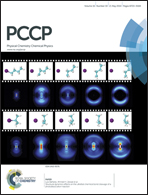In situ profiling of lithium/Ag2VP2O8 primary batteries using energy dispersive X-ray diffraction†
Abstract
In situ, in operando characterization of electrochemical cells can provide insight into the complex discharge chemistries of batteries which may not be available with destructive methods. In this study, in situ energy-dispersive X-ray spectroscopy (EDXRD) measurements are conducted for the first time on active lithium/silver vanadium diphosphate, Li/Ag2VP2O8, electrochemical cells at several depths of discharge allowing depth profiling analysis of the reduction process. This technique enables non-destructive, in operando imaging of the reduction process within a battery electrode over a millimeter scale interrogation area with micron scale resolution. The discharge of Ag2VP2O8 progresses via a reduction displacement reaction forming conductive silver metal as a discharge product, a high Z material which can be readily detected by diffraction-based methods. The high energy X-ray capabilities of NSLS beamline X17B1 allowed spatially resolved detection of the reduction products forming conductive pathways providing insight into the discharge mechanism of Ag2VP2O8.


 Please wait while we load your content...
Please wait while we load your content...